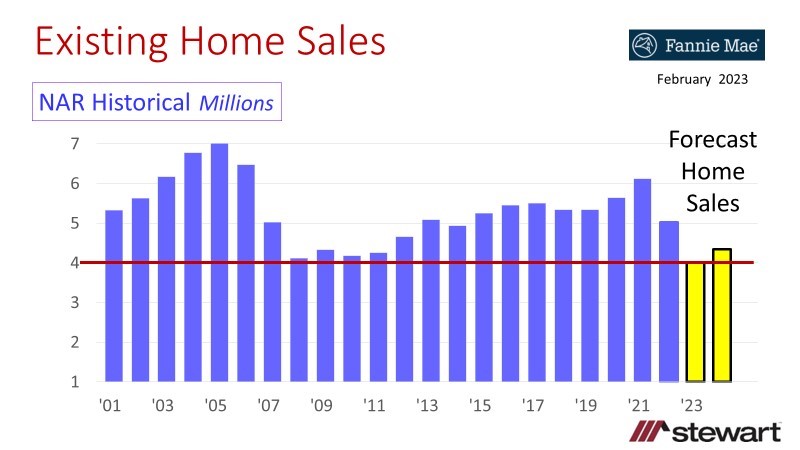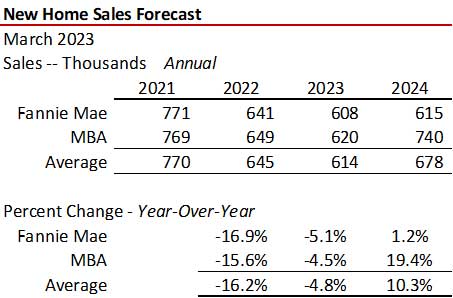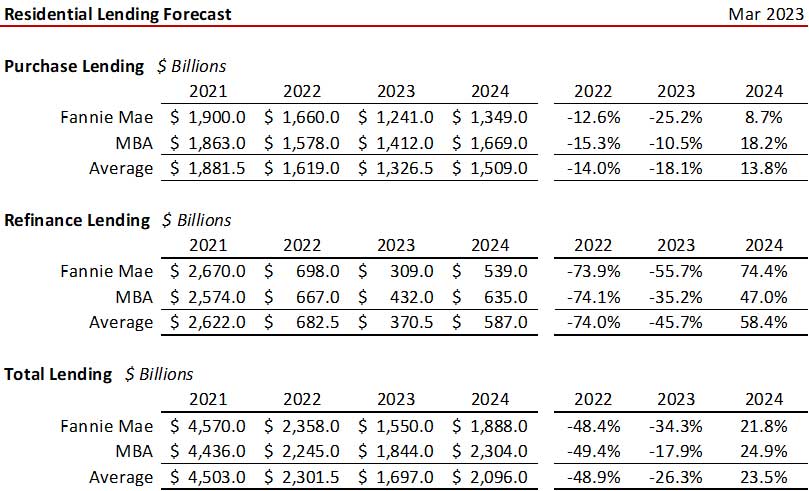Divergent Interest Rate Expectations in Latest Fannie Mae-MBA Home Sales and Residential Lending Forecasts

Residential mortgage interest rates steer the outlook for home sales and residential lending. Historical conventional 30-year fixed-rate mortgage rates are shown in the following graph as reported by Freddie Mac in their weekly Primary Mortgage Market Survey (PMMS). The latest rate as of the week ending April 6, 2023 was 6.28 percent, down from 7.08 percent the last week of October 2022 which was the highest seen in past 20 years.

Interest Rate Expectations
The latest mortgage rate forecasts from Fannie Mae and the MBA are detailed in the table. Fannie Mae sees rates rising 120 basis points from a 5.3 percent average in 2022 to 6.5 percent in 2023. MBA on-the-other hand expects rates to rise slightly from 5.4 percent in 2022 to 5.9 percent in 2023 for a gain of just 50 basis points. The MBA expects rates to drop 100 basis points in 2024 from 5.9 percent in 2023 to 4.9 percent while Fannie Mae sees rates averaging 5.9 percent next year.

Existing Home Sales & Median Prices
Fannie Mae and MBA each forecast declining existing home sales in 2023. Fannie Mae sees sales down 20.1 percent year-over-year to 4.02 million units. The MBA expects 4.22 million existing home sales which would be down 17.1 percent from 2022. In February 2023 the National Association of Realtors® reported that actual closings for the month were down 23.0 percent year-over-year and down 28.7 percent in the first two months of 2023 versus the prior year. Given the MBA’s lower interest rate expectation in 2024, they remain much more optimistic for next year with existing home sales returning to the five million level.
They are similar in their forecasts of median prices, declining from an estimated 4.2 percent to 5.9 in 2023 and essentially flat in 2024.

If Fannie Mae is correct, 2023 will have the fewest number of existing home sales since 1995.

New Home Sales
Since 2002, there has been an average one new home sale for every 8.9 existing home closings. The expectation is for new home sales to be down roughly 5 percent in 2023. Only the MBA see a material rebound in new home sales in 2024, up 19.4 percent compared to a minuscule 1.2 percent gain by Fannie Mae. The average forecast decline in median prices for 2023 is 3.5 percent and another 1.3 percent dip in 2024.


Monthly Principal & Interest Payments 2020 Vs 2023
If the MBA is correct in their current 2023 forecast, the typical P&I payment will be 62.3 percent greater compared to 2020. If Fannie Mae is on target, the monthly P&I payment in 2023 will be up 67.0 percent Vs 2020. The increase in P&I is a function of changes in median price and interest rates and is a primary driver of declining home sales and prices. For 2023, the monthly payment on the median-priced home is expected to be up 8.7 percent year-over-year by Fannie Mae but essentially unchanged by the MBA based on their expected drop in mortgage rates.

Residential Lending
Rising interest rates crushed refinance activity in 2022 compared to 2021 (down 74.0 percent) with another 45.7 percent (average) year-over-year plunge in 2023. More than 6-in-10 residential mortgage lending officers in business in 2021 are now out of a job in the mortgage industry with more cuts announced monthly. When all said and done in this interest cycle, for every 10 residential loan officers in 2021 there will be four or less by the end of 2023.

The chart below shows quarterly year-over-year lending changes for purchase and refinance activity. If correct, there is material pain still coming through the first three quarters of 2023 in the residential lending segment and residential brokerages.

The roller coaster ride continues fueled by Interest rates, jobs, consumer confidence and recession expectations. Stay focused on these metrics. Throw in another banking crisis or other worldwide event and even these forecasts are mute.
Ted
